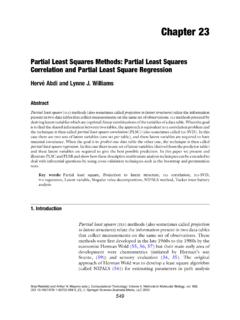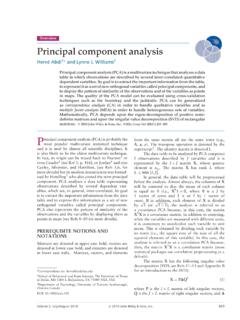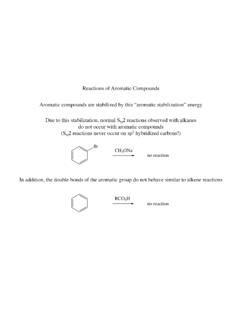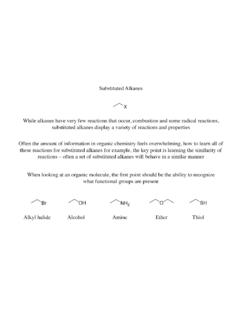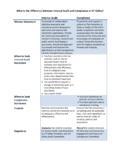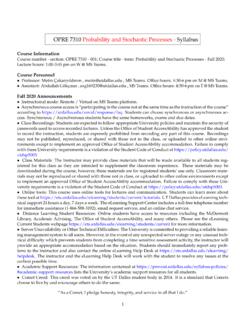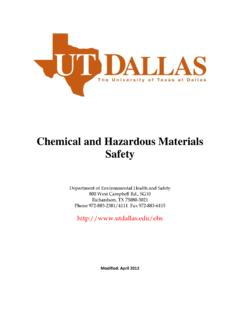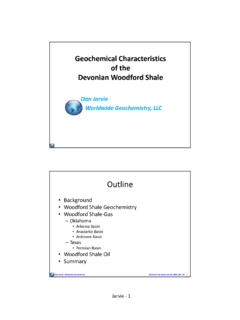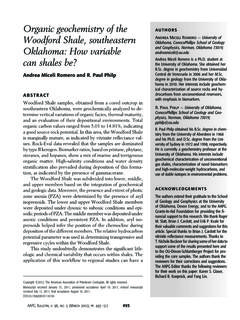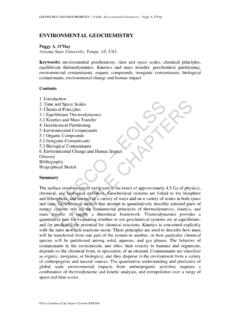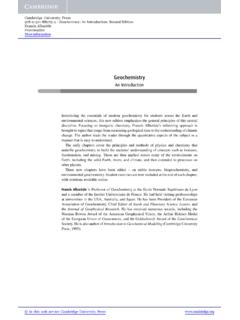Transcription of GEOS 4430/5310 Lecture Notes: Groundwater Chemistry
1 GEOS 4430/5310 Lecture notes : Groundwater ChemistryDr. T. BrikowskiFall 2012 Vers. , Printed: December 3, 2012 Introduction1 What use is Groundwater geochemistry ?Exampleapplicationsoflow-te mperatureaqueousgeochemistry:Simpson-Arb uckle Aquifera potential new source of waterfor Oklahoma city. See USGS Factsheet1 how good is this water for drinking how much can be taken out safely ( where does watercome from) significance of nearby saline and sulfurous wells? (can thiswater be avoided?)Southern Nevada Region Groundwater Systema contaminant1 (Nevada Test Site)? A source of water for thirsty LasVegas2?? can shallow contaminated water reach the currently-cleandeep aquifers?
2 CO2floodingA common secondary recovery method inpetroleum reservoirs. Why CO2, will it accidentally reduceporosity? Examples include DOE-20093, Shiraki and Dunn[2000]2 ,0, Principles: Measurement concentration generally specified as milligramsmgL, this isessentially equivalent to ppm (except in saline waters, whereTDS> 7000mgL) thermodynamic measures [Sec. , Fetter, 2001]: molality: one mole of solute per 1000 gm of solvent is a 1molalsolution molarity: one mole of solute per liter of solvent is a 1molarsolution comparative chemical behavior:millequivalents: concentration ofionicspecies inmgL, multiplied by ioniccharge, and divided by molecular (formula) weight4 a quantitative measure for comparing the chemicalbehavior of dissolved species5 Reactions Reversible reactions reach equilibrium ,thereforereversibility is implied dissociation.
3 Most common type, separation of moleculesinto individual ions ( NaCl) solvent (water) can directly participate in reaction ( reactions) oxidation-reduction: exchange of electrons between ions, appear in the reaction equation, and one or morecations change atomic charge6 Equilibrium Constant (Law of Mass Action) an equilibrium constant can be expressed for an arbitraryreaction ascC +dD xX +yYK=[X]x[Y]y[C]c[D]d(1)where[X]is themolalconcentration of X for an idealsolution, and is thechemical activity aof X for non-idealsolutions a= m, wheremis the molal concentration activity coefficient can be calculated using the Debye-Huckel equation [Eqn.]
4 10-17,Fetter, 2001] if theionic7strengthIof the solution is known [Eqn. 10-16, for TDS< 5000mgLFetter, 2001] Kvalues are tabulated at standard T & P (STP), can bedetermined under other conditions using the expressionK= exp( GorRT)where Goris the Gibbs Free-Energy change of the reactionat STP solubility product: equivalent to the equilibrium constant for dissolution ofa mildly-soluble salt, Na++ Cl (at8equilibrium):Keq=[Na][Cl][NaCl]= [Na][Cl] Ksp because [NaCl] 1, in reality the solubility product isequivalent to the equilibrium constantat equilibrium ion activity product Kiapis the numerator of the equilibrium constant (1) when Kiap>Keq, the salt is supersaturated and willprecipitate (ignoring kinetic effects)
5 Common-ion effect9 is simply that when multiple sources for an ion exist, lessof at least one of those sources will dissolve than if it wasthe only source forthisreason,quantitativecalculationsin volvinggroundwater Chemistry must consider all dissolved andsolid species10pH pH is the negative logarithm of[H+]ion concentration (reallyH3O) a neutral solution has equivalent[H+]and[OH ], theconcentrations are controlled by water dissociation (Fig. 1) since equilibrium constants vary considerably with T, so doesthe neutral pH (at 0 Cneutral pH is , at 25 Cit is ,Fig. 2) should be measured when water sample is collected, since itcan change after a few minutes of atmospheric contact acidsare proton donors to the aqueous solution.
6 Strong11acids tend to completely dissociate, weak acids generallydissociate partially. dissociation of carbonic acid [ , Fetter, 2001]H2CO3 H++HCO 3, K= 10 3 H++CO2 3, K= 10 pH is important because it controls/indicates the distributionof many species. the three-componentsystem C-H-Ocontains sevenspeciesH+, OH ,H2CO3, HCO 3, CO2 3,CO2, H2O. Given the concentration of the components andthe pH, the concentrations of the species can be AutoionizationFigure 1: Autoionization reaction of vs. TFigure 2: Variation of pH vs. of Common SolutionsFigure 3: pH of common solutions (after Purves et al., Life:The Science of Biology, 4th Edition).
7 15 Alkalinity ability of solution to neutralize acid ( to react withH+) generally reported as meq of bicarbonate (HCO 3) +carbonate (CO2 3) CO2 3stable only in highly basic water, so alkalinity isessentially [HCO 3] [Table , Fetter, 2001] in common usage also a measure of the tendency to formcarbonate scale16 Oxidation potential (Eh) in effect Eh is the negativelog10of[e ] field-measured ORP is essentially(Eh 200mV)( seeYSI manual4) oxidationrefers to the removal of electrons from anatom, increasing itsoxidation number(the net charge ofa compound),reductionis the addition of an electron redox pairsgenerally control (buffer) conditions, Fe+2 Fe+3in near-surface oxygenated waters (Fig.)
8 5)4 in nature suchredoxreactions are invariably mediated bybacteria, which use the reactions as an energy source difficult to obtain accurate value in the field, since anycontact with O2dramatically changes Eh often analyzed using Eh-Ph diagram, for determining stabilityof redox pairs ( iron)O2+ 4Fe+2 Reduced+ 4H+ 4Fe+3 Oxidized+ 2H2O(2)O02+ 4 FeII+ 4H+ 4 FeIII+ 2H2O II every redox reaction can be expressed as a pair ofhalf-18reactions, (2) can be expressed as:O2+ 4H++ 4e 2H2O4Fe+2 4Fe+3+ 4e important in many remediation schemes ( air spargingcan clog local aquifer with iron oxide precipitates) presence of organic compounds leads to reducing conditionsby consumption of oxygen breakdown[section , Domenico and Schwartz, 1998]O2(g) + CH2O CO2(g) +H2O(3)19 Redox in BatteriesFigure 4:Redox in a crude battery.
9 Shown is an early battery called the Daniell Cell (for a true battery the twobeakers are connected by a salt bridge, allowing ions to flow between them, and avoiding explosive H2gas formation). Zinc isoxidizedat the anode,donatingan electrone as it dissolves. Cu2+aqacceptselectrons (isreduced), plating onto the total reaction isZn(s)+Cu2+(aq) Zn2+(aq)+Cu(s).20 Redox LadderFigure 5: Redox pairs vs. Eh, most oxidizing environment onthe top, electron donor on the right, acceptor on the left. AfterNIEH Meeting DiagramFigure 6: Eh-pH diagram, showing effect on the solubility ofmetal ions (Fe), after [Fig.]
10 , Fetter, 2001].22A Civil Action: Woburn PCE a famous lethal Groundwater chemical plume court case,memorialized in the movie, jury blamed the most innocentparty see Woburn Spreadsheet Model Homework6 see also animation of best model results76 ~brikowi/Teaching/Hydrogeology/ oxygen (DO) critical for redox reactions and biological processes in last decade became standard to measure DO, wasn t donemuch before that easily measured with a specific probe, useful indicator of Eh can remain in Groundwater far from recharge sites24 Major Ion Chemistry25 Water Analyses collection methods important, see USGS manual [USGS,1998] generally reported in concentrations of actual ions, some (likeSiO2, nitrate NO3)


